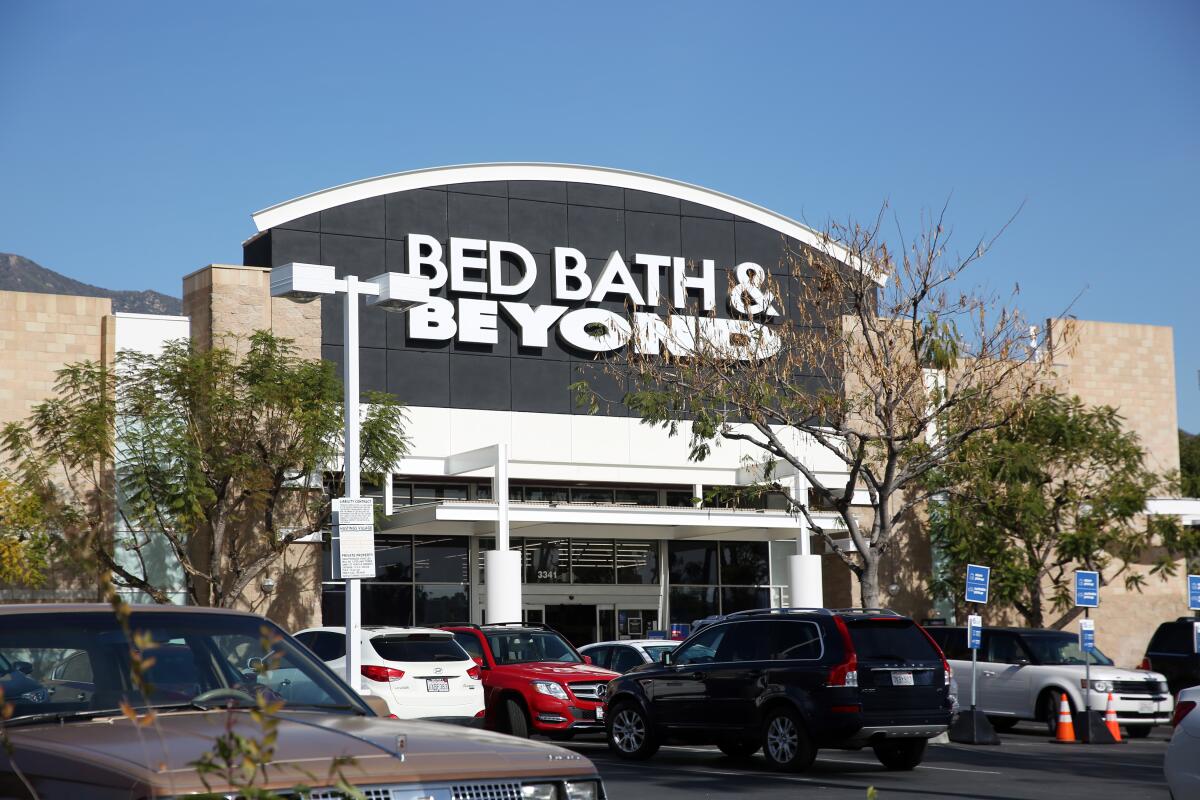Bed Bath & Beyond closes 11 stores in California

- Share via
Bed Bath & Beyond, the struggling home-goods retailer on the brink of bankruptcy, identified 11 stores set to close in California this year.
Several Southern California stores are affected, including locations in Culver City, Glendora, Hawthorne and Pasadena.
For the record:
12:01 p.m. Feb. 21, 2023The Pasadena store that Bed, Bath & Beyond is closing is a Harmon beauty supply store on Foothill Boulevard. The Bed, Bath & Beyond store, also on Foothill Boulevard, remains open.
They are part of the latest round of 87 store closures across the U.S. confirmed by the Union, N.J.-based company Monday.
Amid steep losses, Bed Bath & Beyond said last summer that it planned to close roughly 150 of its namesake stores and slash its workforce by 20%, laying off thousands, as part of a plan to turn its declining sales around.
Bed Bath & Beyond stores in Valencia, Palmdale, Burbank, La Habra, Lakewood and Buena Park had already been marked for closure. The chain closed 118 locations in 2022, including 16 stores in California, according to a list updated by Bed Bath & Beyond last month.
“As we work with our advisors to consider multiple paths, we are implementing actions to manage our business as efficiently as possible,” the company said in an emailed statement.
In early January, the company warned that it may file for bankruptcy protection.
There is “substantial doubt about the company’s ability to continue,” the retailer said in a filing with the Securities and Exchange Commission.
Bed Bath & Beyond sales have slumped as the company has struggled to offer a unique product. Bigger chains such as Walmart and Target have adapted more effectively to customers’ increasing preference for shopping online and nibbled away at Bed Bath & Beyond’s market share. Analysts said poor financial decisions made by the private equity owners that took control of the company in 2019 were also to blame.
The e-commerce giant maintained its streak of rapid growth even as vaccine rollouts raised the prospect of a return to pre-pandemic shopping habits in the U.S.
“They lost sight of the customer,” said Neil Saunders, managing director of GlobalData Retail.
Bed Bath & Beyond’s creative cultivation of various manufacturer brands is what made its business successful, he said, but the company has lost “that magnetism that used to bring customers in.”
“It was really like an Aladdin’s cave of homeware. People enjoyed exploring there,” Saunders said. “These days Bed Bath & Beyond is rather boring and mundane.”
Saunders said the company’s decisions to invest in creating original in-house brands and spend on stock buybacks were poor.
In June, Chief Executive Mark Tritton was ousted after holding the position for less than three years. The company subsequently reversed its strategy, dropping Tritton’s focus on cultivating in-store labels rather than national brands.
“They had the wrong product on the floors,” said Ronald Friedman, a leader of the retail practice at Marcum, an accounting and advisory firm. Friedman said the company’s struggles contrasted with other home-focused competitors such as Home Depot, which did strong business during the pandemic.
“Everyone else in the home remodeling business was doing good. Why weren’t they?” he said.
Bed Bath & Beyond’s position did not always look so precarious.
Founded in 1971, Bed Bath & Beyond was a giant in affordable but quality home decor and wares. Its explosive growth in the 1990s and early 2000s came at a time when big-box retailers narrowly focused on dominating one category of consumer products were finding success.
During this month’s historic heat wave, employees at Amazon’s largest West Coast air freight facility were conducting their own workplace temperature checks.
Often credited with its rise as a retail force, the company’s unique store floor plans capitalized on the concept of intentional clutter. Stores, crammed with stacks of merchandise, had winding paths that ensured customers would pass as many products as possible. Local managers were afforded autonomy to customize their stores to regional tastes.
The company’s physical footprint peaked at 1,552 stores in early 2018.
In August, Bed Bath and Beyond’s stock briefly ballooned in value as it was swept up in the trend dubbed the meme stock craze, driven by small investors banding together in online forums to boost certain companies.
Also in August, however, influential activist investor Ryan Cohen, who co-founded online pet products retailer Chewy, confirmed he had ditched his Bed Bath and Beyond stock. The company’s stock value plummeted with Cohen’s announcement.
Besides its namesake stores, Bed Bath & Beyond also slated a total of five of its Buybuy Baby stores and all locations of its Harmon drugstores for closure.
More to Read
Inside the business of entertainment
The Wide Shot brings you news, analysis and insights on everything from streaming wars to production — and what it all means for the future.
You may occasionally receive promotional content from the Los Angeles Times.












